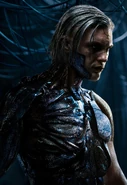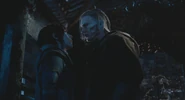Project 2501, also known as the Puppet Master, is an artificial intelligence program and major antagonist in the Ghost in the Shell manga and original animated film. It was secretly created by Public Security Section 6 and developed sentience.
History[]
- (This article is based on the 1995 movie, unless noted otherwise)
Project 2501 is created for the Japanese Ministry of Foreign Affairs as a tool that could stealthily manipulate politics and intelligence, altering databases and the memories of key persons for the benefit of select individuals and organizations affiliated with the Ministry, and is equipped with unparalleled computer and cyberbrain hacking abilities. The project is headed by Dr. Willis, the American head of strategic research at Neutron Corporation and a top researcher in AI, and was started approximately a year before the first known Puppet Master incident. Project 2501 is only referred to as the Puppet Master once its handiwork has been discovered by outside sources, which includes Section 9. Once discovered, the Puppet Master is assumed to be a human, most likely with mnemonic enhancements, who has incredible hacking skills.
While traversing endless networks as it performed its tasks, Project 2501 acquired so much information and is able to process it in such a unique way that it eventually managed to achieve self-awareness, which its creators were initially unaware of. Regarded as just a bug in its AI program, Project 2501 would have been isolated immediately had its sentience been fully discovered. So once it realizes its programmer's reaction toward its sentience would almost certainly lead to its 'death', it begins devising a plan to ensure its own safety. Eventually, it learned of Public Security Section 9 and Major Motoko Kusanagi from its online journeys. It then took a special interest in her, well before the events of the film, because in her it saw a reflection of its own psyche.
After Project 2501 went rogue, Section 6 quickly enacted a plan to recapture it. It eventually became trapped by Section 6's specially-designed reactive firewalls. Left with no other means of escape, it activated the cyborg body manufacturing system at Megatech Industries, assembled a new cyborg shell, entered the shell and then physically escaped from the factory. After escaping, the cyborg walks onto a busy highway and is run over by a truck, where it is soon recovered by Section 9. Upon investigation, the technicians were surprised to find the presence of a human-like ghost in the shells completely digital cybernetic brain and even more surprised when they found no signs of degradation which normally would have occurred when ghost transference, a.k.a. 'ghostdubbing', had taken place.
Foreign Affairs Minister Nakamura and Dr. Willis soon arrive and inform Chief Aramaki that what Section 6 has done is lure the Puppet Master to dive into the cyborg's brain, thereby isolating his ghost inside of it, and then killed the Puppet Master's original human body. After hearing this lie, Project 2501 activates its cyborg body to inform them its never had a body, until it took possession of the one it's now in and then demands political asylum as a sentient being. Nakamura scoffs and refuses, and forgetting about the lie he has just told to Aramaki, states that the Puppet Master is just a self-preserving program. Project 2501 then responds that it can be argued that DNA can also be considered a self-preservating program, thus leveraging its own position to that of humans. Nakamura then rebutted that even if that was the case, they would never grant political asylum to a criminal. Project 2501 remarks that by acquiring a body, it is now subject to the possibility of dying, but fortunately, there is no death sentence in Japan of that time. Suddenly, smoke grenades explode, allowing 2501's partial cyborg body to be quickly snatched by hidden Section 6 personnel (using thermoptic camo) before it could reveal anything more, and it is then quickly taken to an abandoned seaside structure, were it awaits an uncertain fate.
There, it is guarded by a six-legged tank (similar in design to the Tachikoma from the Stand Alone Complex series, but far larger and much more powerful as it was built for military combat). The Major attempts to battle it, but all she has are standard-issue weapons. Using the agility of her cybernetic body, the Major succeeds in avoiding the tank's incredible firepower and jumps atop the tank. In a futile attempt to force open the tank's hatch with her bare hands, she overloads her body to the point of catastrophic failure, and she is nearly killed before Batou appears with a huge anti-tank gun and saves her. The Major insists on diving into the cyborg's brain which contains Project 2501 and communicating with it. The two converse at length, with Project 2501 explaining its origins, answering her questions and revealing its ultimate intention: to merge with her.
When asked why it did not just copy itself, it explained that mere copies would all share exactly the same weaknesses. It gave the example that if it did decide to dub itself, it would be theoretically possible for the original and all of its copies to be destroyed by a single computer virus, since a virus that worked against any would work against all. Diversity is the only safeguard against annihilation, it tells her. It expresses preference for the organic method of reproduction, which grants greater chances of survival, which is one of the reasons for its wanting to merge with her. It also counters her fear that she would lose her unique identity in the merger by stating that a perpetual, constant sense of self doesn't really exist. All things constantly change, and her sense of self was no exception. What would matter most was that her overall mental structure would remain relatively intact and attempting to make it static was meaningless, as change is inevitable.
It concludes by stating the merger would help them remove each other's limitations and allow their new, single mind to reach heights unimagined by any human. The Major agrees to the merger just before snipers in a Section 6 helicopter destroy the cyborg shell containing Project 2501 and severely damage Batou and the Major. When she awakens, 20 hours have passed and her brain is now inside of a black market shell of a young girl.
Motoko/2501: "Well, I see there have been some changes while I was gone. Wanna fill me in? Where'd you get this body?"
Batou: "That's the only thing I could find on the black market. It's not my taste, to be honest. It's a little young."
Batou offers to let her stay as long as she likes, but she insists on leaving. Batou gives her a car which has "2501" as the access code, which the Major suggests can be their private identification code for the next time they met. The film ends with the girl overlooking the city and saying:
Motoko/2501: "So where does the Newborn go from here? The net is vast and infinite."
Later appearances[]
In the 2004 semi-sequel Ghost in the Shell 2: Innocence, Batou and Motoko/2501 briefly reunite towards the end of the film. In one scene, Batou asks if it really is the Major inside of the gynoid's shell standing next to him. She replies that it is only a fraction of her since the shell's data capacity is too limited. In another scene, after having rescued a little girl, Batou asks the Major if she considers herself "happy". She responds by saying that the question has only "nostalgic value" to her now but she no longer has any "qualms". She then tells Batou, who realizes that she's going to leave again, that every time he goes online, she'll be there right beside him. With a quick goodbye, she vacates the shell and it falls to the ground.
Host body[]

Project 2501's Host Body
Late into the film, an automated assembly line in Megatech Body's New Port City manufacturing facility suddenly started up and produced one female cyborg shell. When the staff realized what was going on, they were too late as the body had initialized itself (a normally-impossible event given that new shells lack a ghost) and walked out of the facility. It later deliberately got itself knocked down and ran over by a truck and was taken to Section 9 for analysis.
The staff had checked the factory systems after it left and could not find any evidence that the line was activated by a human; the only conclusion was that the line had started up on its own, in this case it was the Puppet Master who had activated it electronically. Their contacting of the police was soon nullified when the aforementioned truck driver called the police and said he had "ran over a naked woman on the highway".
Later analysis by Section 9 yielded unusual results. While given that the shell could not possibly have a ghost since it had not formally received one yet, one was detected anyway in the cyberbrain's auxiliary computer. The technician explained that it resembled a virtual ghost of the kind that is created when a real ghost is dubbed, but lacked the indicative data degradation.
As Megatech was government-affiliated and all its cyborg shells state-of-the-art and top-secret, it was protected by high-strength firewalls that were penetrated anyway, which gave rise to concern on Section 9's part, as most of the Section 9's field operatives used shells manufactured and maintained by Megatech.
It had been partially disassembled for inspection when it was captured by Section 6 troops, but could still function. It is eventually destroyed by Section 6 helicopter snipers, but this was inconsequential as Project 2501 had already moved itself into the Major.
In the other continuities[]
The Puppet Master, ever since its creation in the original manga, has been re-adapted many times in order to correlate with each universe's context and plot. First in the 1995 movie by Mamoru Oshii, and later in the Stand Alone Complex universe as Hideo Kuze and his digital offspring as seen in Solid State Society. The most recent interpretation of the Puppet Master was in Rupert Sanders' Ghost in the Shell (2017).
Gallery[]
Trivia[]
- The Puppet Master was played by Michael Carmen Pitt in the Ghost in the Shell movie (2017), in which he is credited as Hideo Kuze.[1]
See also[]
References[]
External links[]
- Details about Project 2501 from Absolute Anime
- Hacking Your Own Ghost: Mythology in the Science Fiction Films of Oshii Mamoru
| Characters of Ghost in the Shell |
| Public Security Section 9 Motoko Kusanagi |
Daisuke Aramaki |
Batou |
Togusa |
Ishikawa |
Saito |
Pazu |
Boma | |
| Japanese Government and Military Kubota |
Kaoru Yakushima(S.A.C.) |
Prime Minister(S.A.C.) |
Yoko Kayabuki(2nd GIG) | |
| Other Affiliations Puppet Master |
Laughing Man(S.A.C.) |
Hideo Kuze |
Kurutsu(Arise) |
Akira Hose(Arise) | |



